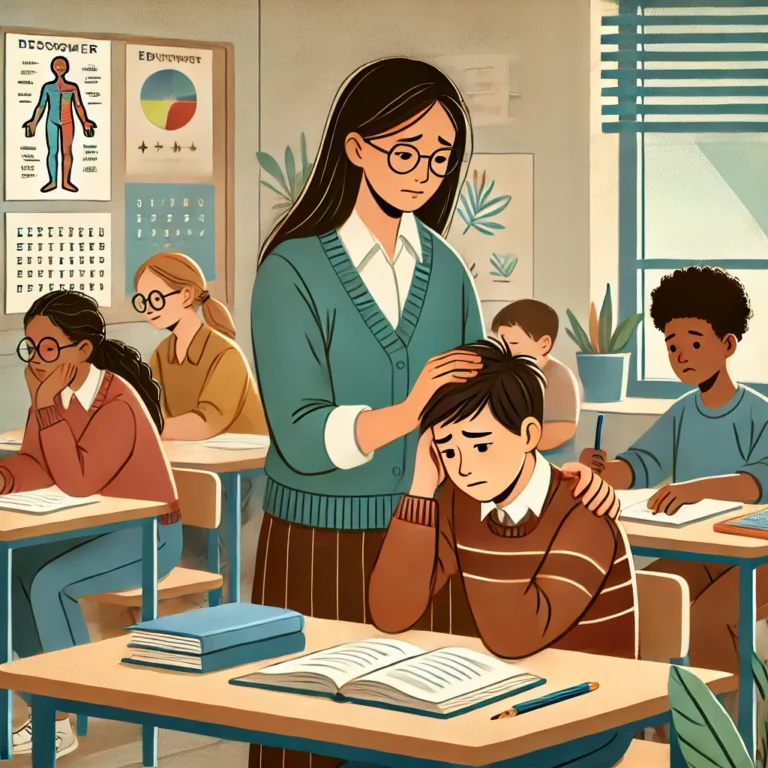Introduction
Anxiety in school can be mistaken for other issues like ADHD or learning disorders. This misunderstanding can lead to inappropriate interventions and support for the child, exacerbating the underlying anxiety. School anxiety is a common but often overlooked issue that affects many children, impacting their academic performance and overall well-being.
In this blog post, we will explore the various aspects of school anxiety, including its symptoms, different forms, and its impact on children. We will also discuss how parents and teachers can recognize the signs of anxiety and provide appropriate support. Drawing on insights from the Child Mind Institute and other expert sources, this comprehensive guide aims to shed light on this critical issue and offer practical strategies for managing school anxiety.
Recognizing School Anxiety
Misdiagnosing Anxiety
Anxiety in school can be mistaken for other issues like ADHD or learning disorders. Both anxiety and ADHD can present with similar symptoms, such as inattention, restlessness, and disruptive behavior, making it challenging to distinguish between the two. However, while ADHD is a neurological disorder, anxiety is a mental health condition that can be managed with appropriate interventions.
It is crucial for educators and parents to understand the differences between these conditions to avoid misdiagnosis. Mislabeling anxiety as ADHD or a learning disorder can lead to inappropriate treatment plans, such as unnecessary medication, which may not address the root cause of the child’s struggles.
Physical Symptoms of Anxiety
Physical symptoms of anxiety in kids include headaches, stomach aches, and trouble breathing. These symptoms can often be mistaken for medical issues, leading to unnecessary visits to healthcare providers. Recognizing that these physical manifestations can be linked to anxiety is essential in providing the right support for the child.
When children complain of frequent headaches or stomach aches, parents and teachers should consider the possibility of anxiety. These symptoms are often accompanied by other signs of distress, such as avoiding school or appearing unusually nervous. Addressing the anxiety can help alleviate these physical symptoms and improve the child’s overall well-being.
Behavioral Manifestations of Anxiety
Inattention and Disruptive Behavior
Anxiety can manifest as inattention, restlessness, and disruptive behavior in the classroom. Children with anxiety may appear distracted, unable to focus on their work, or frequently out of their seats. These behaviors can be misunderstood as defiance or a lack of interest in learning, leading to disciplinary actions that do not address the underlying issue.
Teachers need to be aware that anxiety can impact a child’s ability to concentrate and behave appropriately in class. Providing a supportive and understanding environment can help reduce these anxiety-driven behaviors. Strategies such as giving the child breaks, creating a calm classroom atmosphere, and offering reassurance can make a significant difference.
Different Forms of Anxiety
Separation anxiety, social anxiety, and selective mutism are different forms of anxiety that can affect kids in school. Separation anxiety often manifests in younger children who struggle to be away from their parents, leading to clinginess and difficulty attending school. Social anxiety involves a fear of social situations and can cause children to avoid group activities or interacting with peers.
Selective mutism is a severe form of anxiety where a child is unable to speak in certain situations, despite being able to talk comfortably in others. Understanding these different types of anxiety is crucial for providing the right support and interventions tailored to each child’s specific needs.
Impact of Anxiety on Social and Academic Life
Avoidance and Social Withdrawal
Kids with anxiety may avoid socializing, group work, or participating in certain activities. This avoidance behavior is often a coping mechanism to manage their anxiety. However, it can lead to social isolation and hinder the development of essential social skills. Children who avoid social interactions may struggle to build friendships and feel disconnected from their peers.
Teachers and parents can help by encouraging gradual exposure to social situations in a supportive manner. Providing positive reinforcement and creating opportunities for safe social interactions can help children with anxiety feel more comfortable and confident in social settings.
Attendance Problems and Clinginess
Anxiety can lead to attendance problems, clinginess, and trouble turning in homework. Children with severe anxiety may refuse to go to school, a behavior known as school refusal. They may also exhibit clinginess, refusing to leave their parents or staying close to them in school settings. This behavior can disrupt their education and cause significant stress for both the child and their family.
Addressing the root causes of anxiety and working with mental health professionals can help manage these behaviors. Developing a structured routine, offering reassurance, and involving the child in creating a plan to manage their anxiety can improve attendance and reduce clinginess.
Anxiety and Classroom Performance
Difficulty with Participation
Kids with anxiety may have trouble answering questions in class or freeze up when called on. This fear of being judged or making a mistake can prevent them from participating actively in classroom discussions. Teachers may notice that these children often avoid eye contact, look down, or seem tense when asked to speak.
Creating a supportive classroom environment where mistakes are seen as learning opportunities rather than failures can help reduce anxiety. Encouraging participation through positive reinforcement and providing alternative ways to contribute, such as written responses, can also be beneficial.
Physical Symptoms in Academic Settings
Anxiety can cause physical symptoms like headaches, nausea, and racing heart in kids. These symptoms can be particularly pronounced during stressful situations such as tests, presentations, or even regular classroom activities. Recognizing that these physical complaints may be related to anxiety rather than illness is essential for providing appropriate support.
Teachers can help by offering accommodations such as extended time for tests, a quiet space for work, and breaks during stressful activities. Teaching relaxation techniques and encouraging regular physical activity can also help manage these physical symptoms of anxiety.
Misdiagnosis and Academic Impact
Anxiety vs. Learning Disorders
Anxiety can be mistaken for learning disorders when kids doubt their abilities in certain subjects. For example, a child who experiences anxiety about math may struggle with math problems not because of a learning disorder but due to the anxiety interfering with their ability to think clearly. This misinterpretation can lead to incorrect interventions that do not address the root cause.
It is important for educators and parents to consider anxiety as a potential factor when a child struggles in specific academic areas. Comprehensive assessments by mental health professionals can help differentiate between learning disorders and anxiety, ensuring that the child receives the appropriate support.
Awareness and Support
Teachers and parents should be aware of the signs of anxiety in kids at school to provide appropriate support. Recognizing the symptoms of anxiety and understanding its impact on a child’s academic and social life is the first step in providing effective interventions. Collaboration between educators, parents, and mental health professionals is crucial in developing a comprehensive support plan for the child.
By creating an inclusive and supportive environment, schools can help children with anxiety thrive academically and socially. Providing access to mental health resources, offering professional development for teachers, and involving parents in the process are key strategies in addressing school anxiety.
Conclusion
Understanding and addressing school anxiety is essential for promoting the well-being and academic success of children. By recognizing the symptoms and providing appropriate support, educators and parents can help children manage their anxiety and thrive in school. Collaboration and awareness are key in ensuring that children receive the help they need to overcome the challenges associated with anxiety.



